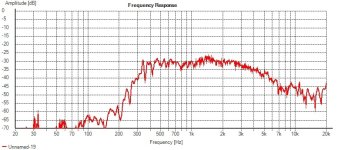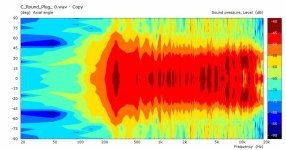I'm really starting to think that the straight channels are flawed design from the start.
Why you think so ?
I went through 20ish itterations and still running into issues.Yeah, I've tried something very similar. It doesn't seem to work so well in practice and my explanation was that it magnifies all the deviations from wavefront coherency to a much larger area, making it simply worse. For this to work as intended, you would probably need a perfect driver.
There was some success (not mine) with BMS 4550, but that's still a small driver:
https://www.diyaudio.com/community/attachments/bms4550_4vaneplug-png.1004919/
Make it bigger and the problems grow. @aragorus probably made the biggest effort testing these things.
There may be some room for improvement in phase plugs though. We'll see.
On the simulations I've managed to push all resonances above 20k, but in reality there are some in the 10-15k region.
I belive that the wavefront at he CD's exit doesn't exactly follow a spherical to flat shape evolution with frequency.
That I think this is probably caused by the design of the Celestion Axi2050's phaseplug.
In the Berstis lens paper there was a pretty neat way of measuring wavefronts, but I'm not sure how feasible that will be with measuring the CD exit's waveform without disturbing it at the same time.
A friend of mine got an SLA printer and we are trying to print a plug on it with transparent resin. So far it proves to be more difficult than making it on an FDM printer.
Here is the current state of affairs:
The driver itself is not very smooth above 10k and the ESP plug makes it even less so.
The contour plot is made with in room measurements, 5 degree resolution and 20ms window. There are some room reflections.
The plug is mounted on a 50cm ish concenric horn.
The frequency response plot contains the raw reponse, the contour plot response is EQ'd flat-ish on axis and is not normalised.


I'm setting up an ABEC framework for the task, and what's interesting is that even if the phase plug itself is plain poor (here it's just randomly assembled), after some length of a subsequent (on-the-end-damped) tube, it tends to smooth out - I guess these are the evanescent modes. The conical exit sections of compression drivers probably also help to "flatten" the wave before it enters a horn.



(14, 19 a 20 kHz for some random geometry.)

(14, 19 a 20 kHz for some random geometry.)
Last edited:
Thanks! I wasn't aware of that work. Only too bad it's for a radial-slits geometry.
But in their reference [7] they write "Visco-thermal boundary-layer losses are included in a post-processing step, and, though the influence of losses is clearly noticeable, the overall performance is similar and the optimized designs still outperform the original design.", which is encouraging.
But in their reference [7] they write "Visco-thermal boundary-layer losses are included in a post-processing step, and, though the influence of losses is clearly noticeable, the overall performance is similar and the optimized designs still outperform the original design.", which is encouraging.
Last edited:
So far I haven't encountered a paper that would even mention the area expansion(s) inside a phase plug itself. Sometimes, equal impedances at the slot entrances are assumed, that's about all. This seems strange. Is there a reason for this to not be so important?
It goes slowly. Too few rainy days...

It goes slowly. Too few rainy days...
Last edited:
If I think about it, maybe expansion rate is of low imortance compared to other parameters like equal imedance and length. Shaping a defined exit wavefront and keep equal pressure over the diaphragm seems most important. All dimensions inside the plug are just a fraction of a wavelength (except depth maybe) at all frequencies and the pressure is high. An expansion rate mismatch to the horn throat may not cause much of a problem since it will mostly play a role at the lower frequencies where plug depth is also very small.
//Anders
//Anders
Aren't these coupled?If I think about it, maybe expansion rate is of low imortance compared to other parameters like equal imedance and length.
- I don't know, maybe it's just the input and output areas that actually matter, no matter what is in between. It just doesn't seem right to me. I like this idea of zero-expansion geometry, i.e. to have a constant area through each channel, input to output. I shall wait till I have some simulations at hand, I guess.
Last edited:
After all, it's possible to shape the exit into a spherical wavefront even with a concave dome. We only need a higher degree of the splines than cubic (this is five, six should be more than enough) -

(All the same length, constant areas through the plug)
(All the same length, constant areas through the plug)
I was a bit too quick here. Cone is not nearly as efficient as wave "flattener" as a tube -The conical exit sections of compression drivers probably also help to "flatten" the wave before it enters a horn.
(The same geometry as before, only now connected to a conical duct.)
Levels:
Phases:
Which I interpret as that the cutoffs of the higher order modes must be noticeably lower.
Last edited:
Perhaps it should be the other way around.Throat.Ext.Length = 0
Throat.Ext.Angle = 70
- Home
- Loudspeakers
- Multi-Way
- Acoustic Horn Design – The Easy Way (Ath4)